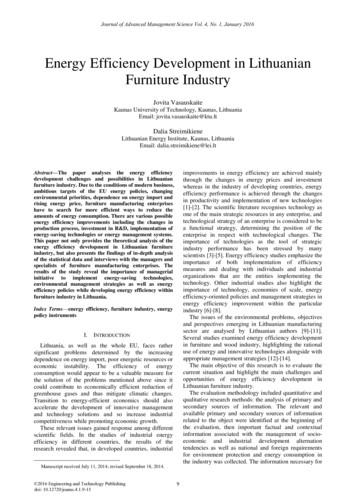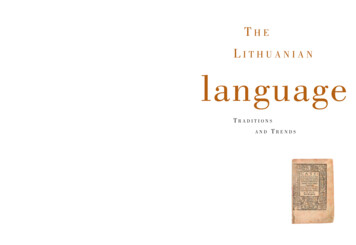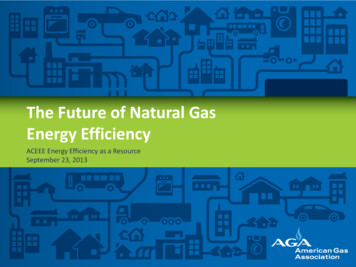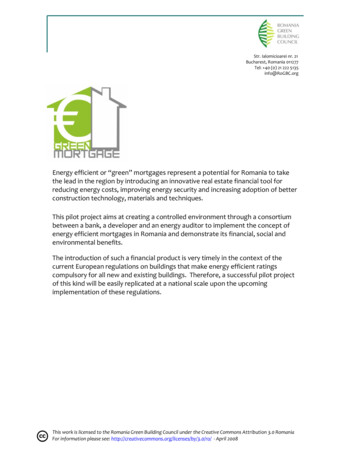
Transcription
Journal of Advanced Management Science Vol. 4, No. 1, January 2016Energy Efficiency Development in LithuanianFurniture IndustryJovita VasauskaiteKaunas University of Technology, Kaunas, LithuaniaEmail: jovita.vasauskaite@ktu.ltDalia StreimikieneLithuanian Energy Institute, Kaunas, LithuaniaEmail: dalia.streimikiene@lei.ltimprovements in energy efficiency are achieved mainlythrough the changes in energy prices and investmentwhereas in the industry of developing countries, energyefficiency performance is achieved through the changesin productivity and implementation of new technologies[1]-[2]. The scientific literature recognises technology asone of the main strategic resources in any enterprise, andtechnological strategy of an enterprise is considered to bea functional strategy, determining the position of theenterprise in respect with technological changes. Theimportance of technologies as the tool of strategicindustry performance has been stressed by manyscientists [3]-[5]. Energy efficiency studies emphasize theimportance of both implementation of efficiencymeasures and dealing with individuals and industrialorganizations that are the entities implementing thetechnology. Other industrial studies also highlight theimportance of technology, economies of scale, energyefficiency-oriented policies and management strategies inenergy efficiency improvement within the particularindustry [6]-[8].The issues of the environmental problems, objectivesand perspectives emerging in Lithuanian manufacturingsector are analysed by Lithuanian authors [9]-[11].Several studies examined energy efficiency developmentin furniture and wood industry, highlighting the rationaluse of energy and innovative technologies alongside withappropriate management strategies [12]-[14].The main objective of this research is to evaluate thecurrent situation and highlight the main challenges andopportunities of energy efficiency development inLithuanian furniture industry.The evaluation methodology included quantitative andqualitative research methods: the analysis of primary andsecondary sources of information. The relevant andavailable primary and secondary sources of informationrelated to the object were identified at the beginning ofthe evaluation, then important factual and contextualinformation associated with the management of socioeconomic and industrial development alternationtendencies as well as national and foreign requirementsfor environment protection and energy consumption inthe industry was collected. The information necessary forAbstract—The paper analyses the energy efficiencydevelopment challenges and possibilities in Lithuanianfurniture industry. Due to the conditions of modern business,ambitious targets of the EU energy policies, changingenvironmental priorities, dependence on energy import andrising energy price, furniture manufacturing enterpriseshave to search for more efficient ways to reduce theamounts of energy consumption. There are various possibleenergy efficiency improvements including the changes inproduction process, investment in R&D, implementation ofenergy-saving technologies or energy management systems.This paper not only provides the theoretical analysis of theenergy efficiency development in Lithuanian furnitureindustry, but also presents the findings of in-depth analysisof the statistical data and interviews with the managers andspecialists of furniture manufacturing enterprises. Theresults of the study reveal the importance of managerialinitiative to implement energy-saving technologies,environmental management strategies as well as energyefficiency policies while developing energy efficiency withinfurniture industry in Lithuania. Index Terms—energy efficiency, furniture industry, energypolicy instrumentsI.INTRODUCTIONLithuania, as well as the whole EU, faces rathersignificant problems determined by the increasingdependence on energy import, poor energetic resources oreconomic instability. The efficiency of energyconsumption would appear to be a valuable measure forthe solution of the problems mentioned above since itcould contribute to economically efficient reduction ofgreenhouse gases and thus mitigate climatic changes.Transition to energy-efficient economics should alsoaccelerate the development of innovative managementand technology solutions and so increase industrialcompetitiveness while promoting economic growth.These relevant issues gained response among differentscientific fields. In the studies of industrial energyefficiency in different countries, the results of theresearch revealed that, in developed countries, industrial Manuscript received July 11, 2014; revised September 18, 2014. 2016 Engineering and Technology Publishingdoi: 10.12720/joams.4.1.9-159
Journal of Advanced Management Science Vol. 4, No. 1, January 2016Lithuania. Lithuanian furniture production manufacture ispositively influenced by well-developed logisticinfrastructure in the country. The qualitative roadinfrastructure integrated in trans-European nets allows themanufacturers to integrate in the EU and other countries’industry while dealing with international orders. It alsoensures availability of raw materials in Eastern Europeand other countries.Moreover, Lithuanian furniture manufacturers competewith both local and foreign companies since the majorityof Lithuanian furniture is exported.the evaluation was obtained from the strategic documents,statistical data sources, interviews with the managers andspecialists of furniture manufacturing enterprises,evaluations that were previously accomplished in thefields of environment protection and energy efficiencyand other sources. The evaluation process consisted of thecontent, comparative and statistical analysis of theprimary and secondary information.II.ENERGY EFFICIENCY IN LITHUANIAN WOOD ANDFURNITURE INDUSTRYA. Situation Analysis of Lithuanian Furniture IndustrySince the entrance of Lithuania in the EU in 2004, theindustry of chemicals, chemical products and fibres hasbecome the most significant industry in the country.However, it is important to note that the results shown bywood and furniture industry are not less significant foroverall Lithuanian economics considering the fact that itis one of the engines of manufacturing and makes asubstantial part in the industrial structure. According tothe classification of Lithuanian Statistics, Lithuanianwood manufacturing sector is divided into: Manufacture of wood and products of wood, Manufacture of furniture (wooden furniture,upholstered seats with wooden frames, furnitureparts of wood, etc.), Manufacture of paper and paper products.The revival of wood and furniture industry and itsprospects to grow after the economic crisis hascontributed to the improvement of the overall economicstructure. At present, wood and furniture industry is thetype of manufacture which more than others contribute toGDP growth in the country (Fig. 1).Figure 2. Major export destinations for Lithuanian furniture industry,LTL million (Source: statistics Lithuania)As it can be seen in Fig. 2, the export of Lithuanianfurniture has gradually been growing since 2009. Foreigndemand recovery is linked with the global economicincrease which has been observed since 2010. Suchtendencies of export show Lithuanian competitiveadvantage and confirm the marketability of Lithuanianfurniture in foreign countries. During all the researchedperiod, the biggest part of the furniture was exported tothe EU countries, namely Sweden and Germany, andsince 2011, the export to these countries has increasedeven further. Before the beginning of the economic crisis,the biggest part of Lithuanian furniture was exported toGermany (nearly 375 million LTL in 2007); in 2009, thevolumes of the export to Sweden and Germany were verysimilar, with export to Germany slightly (by 0.49 millionLTL) exceeding the export to Sweden. Since 2010, thevolumes of the export to Sweden have consistently grownand reached the leading positions. Such distribution of thecountries by the volumes of the export has beendetermined by the activities of the largest Lithuanianfurniture purchaser - Swedish concern IKEA. Thus, it isextremely important to evaluate the situation ofLithuanian furniture manufacturing companies in bothglobal and regional context.However, it should be noted that Lithuania has theadvantage in international markets for its relatively cheaplabour force as well as cheap local wood. As a result,little investment is made in other value chain componentssuch as production capacity, quality and so forth. Theproducts made by Lithuanian wood and furnituremanufacture are often distributed to the final customer bythe marketing channels managed by Western companiesand trademarks such as IKEA, JYSK and others. ThisFigure 1. Gross value added by the wood manufacturing sector, LTLmillion (source: Statistics Lithuania)The biggest part of the overall wood industry is takenby furniture manufacture growing since 2008. Thegrowth of this industry has been determined by theincreasing furniture export and creation of new furnitureproduction companies. Among the numerous markets thatdrive the forestry-based sector, the furniture marketstands out with a strong image worldwide due to its highlevel of technical and aesthetic quality [15].In 2011, the share of wood and furniture manufacturemade 11 % of the overall sold manufacture production in 2016 Engineering and Technology Publishing10
Journal of Advanced Management Science Vol. 4, No. 1, January 2016spread in wood subsector while the use of moderntechnological equipment, computer-aided productionplanning and management systems as well as processautomation technologies prevail in furniture productionsubsector. Increasing global competition requires moreefficient strategies of investment in technologies linkedwith creation, development and implementation of newtechnologies. Evaluation of technological intensity by theindustry and by the product is based on R&D intensityanalysis. R&D intensity reveals the significance ofscientific research on technological development, butother important characteristics of high technologies stayaside [16]. Summarizing, it can be stated that whileattributing particular activities to the industry of hightechnologies, a complex evaluation should be carried outconsidering the researched factors and their comparability.That is why revelation of the extra role of thegovernment and industry in early stages of technologicdevelopment as well as creation of basic technicalinfrastructure (infra technologies and related standards)are extremely important components in the models of thegrowth of technology-based economics. Both technologyplatforms and infrastructure development require the newattitude towards the efficiency of resource distribution,especially when it concerns long-term processes sincelong-term global competition requires the specific andbalanced resource distribution in each possible cycle oftechnological activity. Such measures can be applied onlyif public and private sectors collaborate in the spheres oftechnologies and the supporting infrastructure.way, the biggest part of Lithuanian wood and furnituremanufacturers do not participate in the chains where thehighest value added is created. Lithuanian furnituremanufacturers focus on the needs of mass market andmiddle-class customers which means participation infierce competition in international arenas and relativelylow profit margins.B. Energy Efficiency in Lithuanian Furniture IndustryIn spite of being easily-managed, energy costs inenergy non-intensive companies operating in furnitureindustry are often considered as fixed overheads.However, due to the constant growth of energy prices,furniture production companies face the need to useenergy efficiently and practice innovative ways of energymanagement with a view to increasing their profits,which leads to restructuring towards lower energyintensity and higher value-added manufacturing. The shiftto energy-efficient production should also accelerate thedevelopment of innovative technological solutions andincrease industrial competitiveness while promotingeconomic growth. From the perspective of furnituremanufacturing enterprises, the role of energy efficiency issignificant as it leads to direct economic benefits,increased competitiveness and higher productivity.In the EU, industrial energy intensity fell down byabout 15% during the period of 2005-2012. However, arecovering economy requires more energy, especially forLithuania whose economic structure and sectors bearing ahigh vulnerability to energy sources are predominant, i.e.the manufacturing industry.C.The Main Challenges of Energy Efficiency inLithuanian Furniture IndustryAlthough furniture industry is one of the strongestindustries with modern technologies and application ofnew software, it faces numerous challenges the main ofwhich emphasized by the experts are as follows: Increasing export of raw material causing theutilization of smaller raw wood quantities in thenational industry and the rise of raw materialprices for local furniture production companies.Lithuania has 830,000 hectares of state-owned forests,run by 42 companies. The government now proposes toset up a single forestry company, charged with managingthe industry on a commercial basis. The absence of thesystematic approach towards the interaction betweenwood and furniture sectors determined the paradoxicalsituation in Lithuanian wood sector: investors retreateddue to the lack of raw material, and foresters could notsell the raw material due to high prices, especially duringthe period of economic recession. The lack of rawmaterial has also been determined by the surplus of thenumber of sawmills in the market and invariable supplyof raw wood during the periods of wood industry growth.Due to the lack of wood, which has been determined bythe development of the equipment, the prices of rawwood are inevitably increasing. The main reasons of theincrease are as follows: increasing competition betweenthe stokeholds using wood as fuel and the manufacturersof pressed fuel and wood panels, inexpedient use ofcutting waste and the development of chipboardFigure 3. Total final energy consumption (TCF) in manufacturingsector in 2012, %. (source: Lithuanian Energy Institute report, 2013)Wood and furniture industry is engaged inmanufacturing and assembly of furniture parts alongsidewith appropriate finishing operations. Wood and woodbased materials are the main types of raw material used urers and building administrators show theirincreased interest in energy efficiency solutions andsaving. In the furniture industry, the companies havemade substantial investment in infrastructure andequipment: more than 50 per cent of wood and furniturecompanies use modern technologies in their activities.Efficient waste management technologies are wide 2016 Engineering and Technology Publishing11
Journal of Advanced Management Science Vol. 4, No. 1, January 2016manufacture. In addition, recently wood prices went upevery six months, and furniture manufacturers had noother alternative but to adapt to the new prices in order tocomplete their orders. With the emergence of the lack ofraw material, furniture manufacturing companies payhigher costs, but they cannot increase furniture prices toavoid the decrease of competitiveness. Energetic vulnerability increasing due to risingprices of energy resources.With insufficient own resources of primary energy,Lithuania’s economy depends on the import of theseresources (gas from a single supplier); thus, it isvulnerable, especially in the event of disruptions ofsupply or considerable fluctuations in prices. Looking atthe period between 2008 and 2012, industrial electricityprices in EU Member State have gone up by about 3.5%per year, while industrial users in countries such asEstonia, Lithuania and Latvia have experienced annualgrowth of more than 8% [17].Assessing the human resources in this industry, itshould be noted that the quality of the resources ismedium or low. In addition, by particular aspects (e.g. thequality of managers and engineers’ training), the situationin the industry is poorer than that in other industries or allover the country.Implementation of advanced technologies andcomputer-operated equipment in furniture industrydetermines the need of skilled employees with highereducation to perform technical, maintenance andmanagement functions. Employees’ skills to work withdigital machines and maintain them, apply properfurniture finishing methods and complete sewing, cuttingand modelling works for soft furniture production arerequired. Organization of work is also important, forinstance, operative and cooperative work in groups issometimes much more efficient; it significantly reducesthe order completion time and improves exploitation ofequipment. However, such organisation of work requiresmulti-skilling of employees, which make even biggerchallenges for the enterprises. Increasing dependence on strategic actions ofIKEA concern.Swedish concern IKEA is planning a double expansionby 2020 which means that Lithuanian furniturecompanies will also need to increase the volumes ofproduction since at present the concern buys 90-98% ofLithuanian furniture export. However, this determines aserious problem: the policy of the IKEA concern ismaking cheap furniture and prompting suppliers to reduceprices. That is why most companies are forced to producefurniture at the lowest costs; they cannot increase pricesand accumulate the funds for modernization, newtechnologies and new furniture design.As a furniture manufacturer, Lithuania is a promisingcountry, but during the period of economic crisis, itproduced labour-intensive production with low valueadded. It was because the value added created by a singleworker was more than ten times lower than that in thecountries leading in furniture manufacturing. It isconsidered that furniture transportation to other countriesmakes a significant part of prime costs. Thus, if the primecost increased, Lithuanian furniture industry could losethe largest customer. Such companies as “Vilniausbaldai”, “Freda”, “Klaipedos baldai” and “Silutes baldai”,which are the main furniture suppliers for IKEA, wouldexperience the most significant loss. It can be stated thatLithuanian furniture companies are dependent on thisconcern, but the advantage is that event during the periodof crisis, IKEA’s sales were intensive. The experts of thisfield point out the following advantages that IKEAconcern brings to Lithuanian furniture industry: increasedproductivity, lower costs, increased efficiency, optimizedprocesses of production and management, investment innew technologies, increased personnel qualification andincreased competitiveness [19].IKEA has not only provided the economic stability tothe Lithuanian enterprises, but also contributed to theirlevel of technological and managerial knowledge(especially what concerns energy efficiency developmentFigure 4. Retailing price of electricity for industrial consumers inBaltic States, 2004-2013, Lt/kWh without VAT. (sources:https://www.energia.ee, https://www.lesto.lt, http://www.latvenergo.lv)An increase in energy demand is considerablyinfluenced by the dynamics of the macroeconomicindicators (GDP growth, structure of branches of theeconomy, etc.), increasing fuel and energy prices,consumer response to rising income and increasingenergy prices, energy efficiency enhancement and otherfactors. Increasing energy prices are causing challengesfor both managers and shareholders; rising costs for fuel,electricity and thermal energy are eating into companyprofit and weakening such enterprises’ competitiveness ininternational markets. What is more, both gas andelectricity prices have significantly increased, soincreasing volumes of production determine highergeneral and administrative costs. Lack of competent, skilled and motivated workers,the lack of production organization experts.Lithuanian furniture industry employs around 24thousands workers in 1.165 enterprises. It is a labourintensive and dynamic industry, dominated by SMEs andmicro firms. The ageing workforce combined withdifficulties to attract young workers may lead todisruptions in maintaining a skilled workforce andcontinuity of traditions and craftsmanship. Furthermore,boosting research and innovation requires sufficientfinance, which is often inaccessible to SMEs [18]. 2016 Engineering and Technology Publishing12
Journal of Advanced Management Science Vol. 4, No. 1, January 2016of advantageous technologies in manufacturingenterprises for production, management and controlimprovement is named as one of the most importantpriorities [20]-[21]. Requirements of these directives aretransferred in a short form into international and nationalEuropean legislation. We have to admit that in Lithuaniathere are quite a lot of problems and gaps which areencountered during implementation of this legislation.The main reasons indicated in the literature sources arethe lack of administrative competence and organizationalresources.A framework for assessing these barriers would needto go far beyond the analysis of financial support toenergy research, but might include an assessment ofinstitutional capacities, policies and measures and theiruse and interplay [23]. An integrated approach would alsobe needed due to the fact that technological innovationcomprises of various distinct steps. However, theinnovation process should not be understood as a linearprocess but rather as a cyclical process with variousfeedback loops between the different phases [7]. Throughthe application of new solutions in business, formation ofwaste and by-products in the production process can beminimized or such waste and by-products can be reusedin the form of raw materials.issues). Negative tendencies in respect of the IKEAconcern are linked with the concentration of sales and thedependence. Thus, Lithuanian enterprises have to look forproduction diversification sources, create strong productlines and brands, gradually decreasing their dependenceon large international customers. Stringency of the EU regulations on the impact theindustrial companies make on environment andthe requirements for the quality of products.During the recent decade, the European Union hasbeen dealing with the issues of global warming which hasled to the implementation of numerous policy instrumentssuch as the EU Emission Trading Scheme (ETS) and theEuropean Energy End-Use Efficiency and EnergyServices Directive (ESD) following which each memberstate is obliged to formulate and design a National EnergyEfficiency Action Plan (NEEAP). ImplementingEuropean Energy Efficiency Plan (COM(2011)0109),Kyoto Protocol concluded under United NationsFramework Convention on Climate Change (UNFCCC)and energy efficiency goals “20-20-20” for 2020, theEuropean Commission and Council focus on the legalacts regulating the promotion of energy efficiencymeasures. The acts which are considered to be the mostimportant to industrial companies are presented in Table I.In all these documents, mentioned above, implementationTABLE I.SUMMARY OF MAIN EUROPEAN COMMISSION DIRECTIVES ON ENERGY EFFICIENCY APPLIES IN INDUSTRYDirective codePurposeDescriptiondirective2012/27/EUon energy efficiencyThis document is treated as obligation to encourage investment in low-carbon dioxidetechnologies, especially in those industrial sectors which are characterized by high risk ofcarbon dioxide leakage; it requires to carry out energy consumption audits in the companiesand to increase the part of cogeneration during production of heat, coolness and electricity.directive2010/31/EUon the energyperformance for buildingsCompanies are obliged to set energy performance requirements for buildings whilemaintaining the balance of investment and saved energy costs during the whole buildinglifecycle; in addition, they are required to implement in buildings advancedmeasurement/management systems.directive2010/30/EUon the indication bylabelling and standardproduct information of theconsumption of energyCompanies are obliged to label the products providing the information on the consumption ofenergy and other important resources; they have to change labelling classification consideringtechnological advancement and energy saving opportunities.directive2008/98/EUon waste and repealingCompanies are obliged to ensure the prevention of environmental pollution by applying theprinciples of electric and electronic equipment and natural waste prevention, management andsafe repealing.directive2009/125/ECon eco-designrequirements for energyrelated productsCompanies are obliged to design their products accurately with a view to saving energy andreducing the negative impact on environment which, in turn, would form the conditions forcost saving for business entities and final consumers; eco-design integration in small andmedium enterprises (SMEs) is also strongly promoted.directive94/62/ECon packaging andpackaging wasteCompanies are obliged to reduce the quantities of all kinds of packaging and packaging wasteby promoting packaging reuse, recycling and other forms of packaging waste utilization.directive2008/1/ECconcerning integratedpollution prevention andcontrolCompanies are obliged to set the measures for the implementation of integrated pollutionprevention and control; the strict procedures for pollution permits issuing and processcoordination have been established. Lack of working capital and increasing debts arethe main barriers while making the decisions onthe implementation of technological innovations incompanies. 2016 Engineering and Technology PublishingThe significant part in the structure of Lithuanianfurniture production industry is made by borrowed capital.During the last five years, it made more than 50%, butrecently has decreased. It means that enterprises havemore opportunities to finance their activities from their13
Journal of Advanced Management Science Vol. 4, No. 1, January 2016Long-term prospects of Lithuanian furniture industrywill depend on the volumes of investment, concentrationlevel, price changes in the energy and labour market andthe effective consumption of raw material and energyresources. A significant role here will be played by thepolitics of Lithuanian government in respect of wood andfurniture industry.own resources. During all the period, the authorizedcapital accounted the biggest share of the borrowedcapital, but at the end of the period, its share decreased,although the volumes increased. Thus, Lithuanianfurniture manufacturers issued more shares. During theperiod of 2010-2012, the part of equity grew up due tothe increased retained earnings.The growth of the sector is restricted by theunderdeveloped capital market infrastructure and poorinnovation infrastructure. The common problems arestuck in settlements and a vicious circle of debts. Theseproblems are faced by the enterprises with creditobligations. Banks limit lending, and business companies’lack of working capital. Companies often need a bankloan not for investing in production, but for coveringexisting debs. On the other hand, different environmentalinitiatives such as eco-design, cleaner production,implementation of energy efficient technologies,environment management systems and so forth aresupported by the government making the conditions toparticipate in various projects, this way attractingadditional funds for activity development.The main funds are intended for the financing of theprojects of industrial enterprises: COSME - for preneurship; Horizon 2020 - for the funding ofscientific research andinnovation; LithuanianEnvironmental Protection Fund (LEPF) - for the projectsof environmental protection, rational use of naturalresources, climate change, waste management; theProgram of Green Industry Innovation - for the projectsof implementation of innovative environment protectiontechnologies and creation of green products [23].Summarizing the results of the analysis of energyefficiency development in Lithuanian furniture indutry, itfollows that the industrial activities are influenced byvarious internal and external factors such as increasingflows of products, human resources and overallmanagement decisions; dynamic growth and increasingcompetition; emerging need for environmentalinformation [24]. In the light of these factors, Lithuanianfurniture industry has undergone significant changes restructuring, technological advances and business modelinnovations, allowing it to be more export-oriented andfocus on upgrading quality, design and innovation.Continuing investment in skills, design, creativity,research, innovation and new technologies can result innew products which are in line with the changingpopulation structure, lifestyles and trends, as well as withnew business models and supplier-consumer relationships.Improved energy efficiency may result in other benefitsthat outweigh the energy cost savings, including: Decreased business uncertainties and reducedexposure to fluctuating energy costs; Increased product quality and switch to higheradded value market segments; Increased productivity; Reduced environmental compliance cost, e.g.greenhouse gases and criteria air pollutants [8]. 2016 Engineering and Technology PublishingIII.CONCLUSIONSThe results from this study show that the mainchallenges for the energy efficiency development inLithuanian furniture industry are: the shortage of rawwood and rise of it‘s prices for the national furnitureenterprises; the rising prises for energy resourses; the lackof competent and multi-skilling employees; increasingdependance on actions of IKEA concern; strictness of theEU regultations; the lack of working capital andincreasing debts.Lithuanian furniture manufacturing enterprises
increasing furniture export and creation of new furniture production companies. Among the numerous markets that drive the forestry-based sector, the furniture market stands out with a strong image worldwide due to its high level of technical and aesthetic quality [15]. In 2011, the share of wood and furniture manufacture made 11 %










